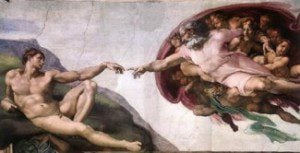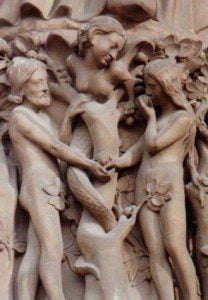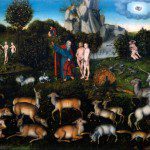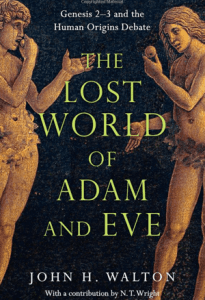 The final chapter of John Walton’s new book The Lost World of Adam and Eve: Genesis 2-3 and the Human Origins Debate looks at the ways in which humans are distinct creatures and a special creation of God. In discussing human origins, Walton draws a distinction between evolution in the sense material continuity and gradual change with time and the mechanisms that drove this process of evolution. I made the same distinction in my recent post “How to Talk About Science and Faith.” He points out that evolution is “not inherently atheistic or deistic,” although some of the mechanisms proposed are. Evolutionary history itself “has plenty of room for the providence of God as well as the intimate involvement of God.” (p. 191)
The final chapter of John Walton’s new book The Lost World of Adam and Eve: Genesis 2-3 and the Human Origins Debate looks at the ways in which humans are distinct creatures and a special creation of God. In discussing human origins, Walton draws a distinction between evolution in the sense material continuity and gradual change with time and the mechanisms that drove this process of evolution. I made the same distinction in my recent post “How to Talk About Science and Faith.” He points out that evolution is “not inherently atheistic or deistic,” although some of the mechanisms proposed are. Evolutionary history itself “has plenty of room for the providence of God as well as the intimate involvement of God.” (p. 191)
As an ancient document Genesis has nothing to say about the science of evolution – it was not an idea in the consciousness of the author, not an idea that was relevant to the theological point of the text. The traditional interpretation that humans were a unique special creation is an interpretation consistent with scripture. Walton asks, however, if it is the only interpretation consistent with scripture. What specific claims does scripture make about human origins?
Genesis 1:26-27 tells us “God said, “Let us make mankind in our image, in our likeness, … So God created mankind in his own image, in the image of God he created them; male and female he created them.”
Genesis 5:1-2 gives us the same: When God created mankind, he made them in the likeness of God. He created them male and female and blessed them. And he named them “adam” when they were created.
Psalm 8 is also significant: What is mankind that you are mindful of them, human beings that you care for them? You have made them a little lower than the angels and crowned them with glory and honor. You made them rulers over the works of your hands; you put everything under their feet. (v. 4-6)
Human distinctiveness isn’t material, it isn’t neurological, and has nothing to do with opposable thumbs. There are aspects of our biology that enable us to function effectively as God’s image in the world – but these traits do not define human distinctiveness or our calling as God’s image.
Walton suggests first, that human distinctiveness is spiritual.
- Adam and Eve are called as priests serving in sacred space. “This is presented as a role given to them by God, a role that is spiritual in nature.” (p. 192-193)
- Humans have a spiritual nature. What this means in terms of body and soul is a matter of some debate. But our spiritual nature is clear – “we believe that we are more than biological specimens; we are more than carbon-based life forms.” (p. 193) There is a part of us that survives the death of the body.
This is not something that can evolve; it is not possessed by those other creatures in a line of common descent. It represents a spiritual discontinuity even if one concludes that there is material continuity. It is granted by God (we don’t know how or when) as a direct special creative act of God, and it differentiates us from every other creature. (p. 193)
- We are created in the image of God. In fact, “the image of God is, by definition, who we are as human beings.” (p. 193) It is, Walton believes, a direct spiritually defined gift of God.
The Image of God. Walton outlines four aspects to the image of God: function, identity, substitution, and relationship.
Function. We are corporately called to function as God’s vice-regents in the world. We may have biological traits as a species that enable us to carry out this role, but the role is true of all humans no matter what there capacities, abilities, or disabilities.
Identity. Naming is an important creative act and “when God designates humankind as his image, that is what humankind becomes.” God gave us the identity of being his image and “this giving of identity is a spiritual act of special creation.” (p. 195)
Substitution. We stand in for God in the world as his substitutes, communicating important ideas about God and his kingship. This is one of the roles of the image of a king in the ancient Near Eastern culture.
We represent his presence in sacred space. His essence makes us spiritual beings and constitutes discontinuity from any other creature. Just as images were revered as divine creatures in the ancient world, we are considered to be the works of God in the truest possible sense. (p. 195)
Divine-human relationship. The term “image of God” implies a special relationship. This aspect of image is seen in Genesis 5:3 where it is said that Adam “had a son in his own likeness, in his own image; and he named him Seth“
The distinctiveness of humans is not material. It is a spiritual, relational, functional distinctiveness. This distinctiveness does not have a natural origin – the human body may be the result of evolutionary process but the spiritual human distinctiveness is a special creative work of God.
Humans are the special direct creation of God in certain ways-that is not in question. The uncertainty lies in how much of that special creation falls into the material category. (p. 197)
Is the human distinctiveness material, spiritual, or both?
What does it mean to be created in the image of God?
If you wish to contact me directly you may do so at rjs4mail[at]att.net
If interested you can subscribe to a full text feed of my posts at Musings on Science and Theology.











